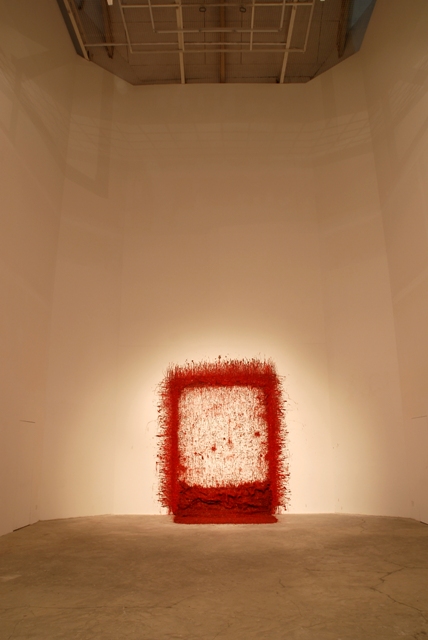strides of colour

(Images courtesy of OSAGE Gallery)
The intent of abstract painting has never been stronger. The investigation of processes and materials has gone bolder. The physical limits of paint, are pushed in an enormous multi-weaved layer sliding to reveal a doorway. At that end of an act of sliding, slipping between calling it ‘document of an action’ in the abstract expressionist tradition, and painting because paint was used, is the prodigious Status (2009). The red gate is unapologetic of the mess it makes of the wall and floor, not unlike the scene of a murder from Aliens, the movie. If it was a crime scene, borrowing an idea from artist/curator Guoliang, the figure – representation in painting – is murdered. The figure, or the need to paint something representational is dumped in Jane’s work. Paint is both the subject (matter) and object. As a subject, it questions the ‘status’ of painting against other art-forms such as Damien Hirst’s shocking diamond crusted skull, and its obscene price tag. As an object, it takes on that visceral, abject quality, like clotted blood or bodily innards.

It is perhaps relevant to consider the scale, and depth of Jane Lee’s work in relation to other abstract painters in Singapore. From a league of established 2nd generation artists, the contemporaries of Ng Eng Teng, we could consider Thomas Yeo, Goh Beng Kwan, Teo Eng Seng and Anthony Poon. The contemporaries of Jane might include Ian Woo, Ho Tzu Nyen, Jeremy Sharma, Boo Sze Yang, Khiew Huey Chian and Yong Tai Si. Ho Tzu Nyen and Yong Tai Si had previously shown at Painting as Process, at Earl Lu Gallery in 2004.
The distinct differences with Jane and the 2nd generation artists, is the sense of scale, access to a range of materials, exposure and gallery support. Jane’s boldness was perhaps encouraged by her monumental wall mural, Raw Canvas (2008) seen in the Singapore Art Biennale 2008. The availability of good quality gels, medium or other painterly additives meant the inventiveness of the artist could move beyond a bricolage of painterly surfaces, to make paint take a 3 dimensional form, yet stay vibrant and luxurious. The support of the gallery is also crucial, allowing the pieces to be arranged in a thoughtful manner, and canvassing academic discourses to surround her work. The two talks held in conjunction with the exhibition are prominent examples to how the gallery supported the artist.
The distinction with the contemporaries, in Singapore and elsewhere are perhaps less clear. Conceptually, ‘painting as process’ runs deep in the works of these artists, as opposed to the traditional understanding of painting as representation, or ‘recognisable pretty picture making’. ‘The ‘play’ might suggest the influence on the artist by a different discipline. For Jane, her textiles training is suggested by the draping, dyes, canvas stripes ‘sewn’ into the gallery’s temporal wooden walls. Painting as process’ almost becomes synonymous with the ‘play’ of material; methodical, malleable transformations that play-doh or blue-tack might take. Any semblance to recognisable forms, are almost always after thoughts, the artists’ clue to new entry points to view the works.
The success of Jane Lee’s paintings can perhaps be summarised as such: they are incredibly beautiful to look at; the rich, dense surface shimmers, dodges and hides all possible conclusion of arriving at a singular interpretation. The surface beckons us, as Tony Godfrey admits in his panel discussion “Painting in Asia Today”, like a dance as the viewer tangos with painting, moving forward, side ways, and back to catch a different glimmering light. The carefully planned colours, encourage us to take strides – to accept abstraction as another tradition of painting, and to indulge in visual excitement.
7.0 of 10 stars
Jane Lee
Osage Gallery
26.09.2009 – 08.11.09

Pingback: 2010 in review |